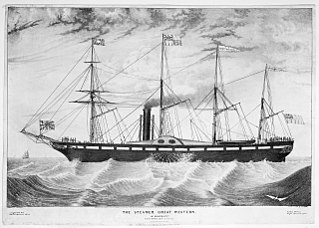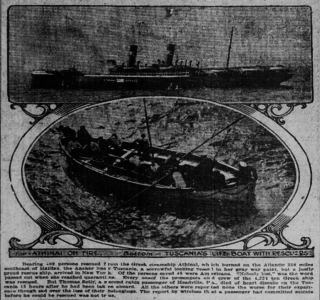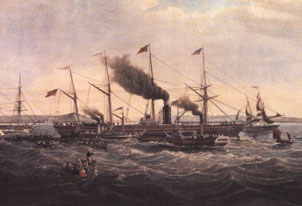
Cunard Line is a British cruise line based at Carnival House at Southampton, England, operated by Carnival UK and owned by Carnival Corporation & plc. Since 2011, Cunard and its three ships have been registered in Hamilton, Bermuda.

A steamship, often referred to as a steamer, is a type of steam-powered vessel, typically ocean-faring and seaworthy, that is propelled by one or more steam engines that typically move (turn) propellers or paddlewheels. The first steamships came into practical usage during the early 1800s; however, there were exceptions that came before. Steamships usually use the prefix designations of "PS" for paddle steamer or "SS" for screw steamer. As paddle steamers became less common, "SS" is assumed by many to stand for "steamship". Ships powered by internal combustion engines use a prefix such as "MV" for motor vessel, so it is not correct to use "SS" for most modern vessels.

The Blue Riband is an unofficial accolade given to the passenger liner crossing the Atlantic Ocean in regular service with the record highest average speed. The term was borrowed from horse racing and was not widely used until after 1910. The record is based on average speed rather than passage time because ships follow different routes. Also, eastbound and westbound speed records are reckoned separately, as the more difficult westbound record voyage, against the Gulf Stream and the prevailing weather systems, typically results in lower average speeds.

An ocean liner is a passenger ship primarily used as a form of transportation across seas or oceans. Liners may also carry cargo or mail, and may sometimes be used for other purposes.

SS Great Western of 1838, was a wooden-hulled paddle-wheel steamship built of Dantzic pine, the first steamship purpose-built for crossing the Atlantic, and the initial unit of the Great Western Steamship Company. She was the largest passenger ship in the world from 1837 to 1839. Designed by Isambard Kingdom Brunel, Great Western proved satisfactory in service and was the model for all successful wooden Atlantic paddle-steamers. She was capable of making record Blue Riband voyages as late as 1843. Great Western worked to New York for 8 years until her owners went out of business. She was sold to the Royal Mail Steam Packet Company and was scrapped in 1856 after serving as a troop ship during the Crimean War.

Generally, packet trade is any regularly scheduled cargo, passenger and mail trade conducted by ship. The ships are called "packet boats" as their original function was to carry mail.

CP Ships was a large Canadian shipping company established in the 19th century. From the late 1880s until after World War II, the company was Canada's largest operator of Atlantic and Pacific steamships. Many immigrants travelled on CP ships from Europe to Canada. The sinking of the steamship RMS Empress of Ireland just before World War I was the largest maritime disaster in Canadian history. The company provided Canadian Merchant Navy vessels in World Wars I and II. Twelve vessels were lost due to enemy action in World War II, including the RMS Empress of Britain, which was the largest ship ever sunk by a German U-boat.

Alfred Holt and Company, trading as Blue Funnel Line, was a UK shipping company that was founded in 1866 and operated merchant ships for 122 years. It was one of the UK's larger shipowning and operating companies, and as such had a significant role in the country's overseas trade and in the First and Second World Wars.
The International Navigation Company (INC) was a Philadelphia-based holding company owning 26 ships totaling 181,000 tons and carried more passengers than either Cunard or White Star, when the company was reorganized as International Mercantile Marine in 1902. INC was formed in 1871 with the backing of the Pennsylvania Railroad to operate foreign flagged vessels on transatlantic routes to Philadelphia. Clement Griscom, the company's general manager, entered into an agreement with the Belgian Government to establish the Red Star Line to operate a mail service out of Antwerp to Philadelphia and New York. This subsidiary would provide most of the company's profits for the next 30 years.

The Inman Line was one of the three largest 19th-century British passenger shipping companies on the North Atlantic, along with the White Star Line and Cunard Line. Founded in 1850, it was absorbed in 1893 into American Line. The firm's formal name for much of its history was the Liverpool, Philadelphia and New York Steamship Company, but it was also variously known as the Liverpool and Philadelphia Steamship Company, as Inman Steamship Company, Limited, and, in the last few years before absorption, as the Inman and International Steamship Company.

SS Republic was an ocean liner built in 1871 by Harland and Wolff for White Star Line. It was intended to be the last of four vessels forming the Oceanic class, before two new ships were commissioned. After a rough maiden voyage from Liverpool to New York City on 1 February 1872, the ship was chosen to be on White Star Line's first voyage on the South Atlantic and Pacific line with four other ships, destined for Chile. In 1874, the construction of modern ships SS Germanic and SS Britannic led to SS Republic's becoming the standby vessel of White Star Line. It occupied this position for 15 years, and attempts were made to modernise it in 1888. When SS Teutonic and SS Majestic entered service in the following year, the Republic became surplus to White Star's needs.
The Collins Line is the common name for the American shipping company started by Israel Collins and then built up by his son Edward Knight Collins, formally called the New York and Liverpool United States Mail Steamship Company. Under Edward Collins' guidance, the company grew to be a serious competitor on the transatlantic routes to the British Cunard shipping company.

SS Athinai was a Greek transatlantic steamer that burned and sank on 19 September 1915.

The Baltimore Steam Packet Company, nicknamed the Old Bay Line, was an American steamship line from 1840 to 1962 that provided overnight steamboat service on the Chesapeake Bay, primarily between Baltimore, Maryland, and Norfolk, Virginia. Called a "packet" for the mail packets carried on government mail contracts, the term in the 19th century came to mean a steamer line operating on a regular, fixed daily schedule between two or more cities. When it closed in 1962 after 122 years of existence, it was the last surviving overnight steamship passenger service in the United States.

RMS Moldavia was a British passenger steamship of the early 20th century. She served as the Royal Navy armed merchant cruiser HMS Moldavia during World War I until sunk by an Imperial German Navy submarine in 1918.

The Great Western Steam Ship Company operated the first regular transatlantic steamer service from 1838 until 1846. Related to the Great Western Railway, it was expected to achieve the position that was ultimately secured by the Cunard Line. The firm's first ship, Great Western was capable of record Blue Riband crossings as late as 1843 and was the model for Cunard's Britannia and her three sisters. The company's second steamer, the Great Britain was an outstanding technical achievement of the age. The company collapsed because it failed to secure a mail contract and Great Britain appeared to be a total loss after running aground. The company might have had a more successful outcome had it built sister ships for Great Western instead of investing in the too advanced Great Britain.
The British and American Steam Navigation Company was a steamship line that operated a regular transatlantic service from 1839 to 1841. Before its first purpose-built Atlantic liner, British Queen was completed, British and American chartered Sirius for two voyages in 1838 to beat the Great Western Steamship Company into service. B & A's regular liners were larger than their rivals, but were underpowered. The company collapsed when its second vessel, President was lost in 1841.

SS Baltic was a wooden-hulled sidewheel steamer built in 1850 for transatlantic service with the American Collins Line. Designed to outclass their chief rivals from the British-owned Cunard Line, Baltic and her three sister ships—Atlantic, Pacific and Arctic—were the largest, fastest and most luxurious transatlantic steamships of their day.
The Atlantic Steam Navigation Company was founded in 1934 with the original object of providing a no-frills transatlantic passenger service. A combination of difficult economic conditions and then World War II frustrated these early ambitions.

The SS Caracas (1881–1889) was a coastal passenger steamship built by William Cramp & Sons in Philadelphia. She was the older sister ship to the Valencia. Both Caracas and Valencia served from New York City to Venezuela. The short life of Caracas ended in 1889, when she ran aground in Yaquina Bay under the name Yaquina Bay.


















